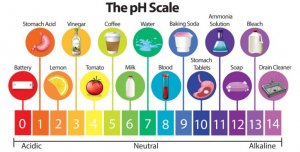The Importance of pH Balance in our Body

Perhaps when you read or hear about pH balance you immediately think of soap or face cream, but, this is something that’s also present in the human body. Therefore, in the next article, we’ll tell you how you can achieve a balanced pH in your body.
Maintaining the pH balance in your body
Having a balanced pH is essential to remain healthy and to look good. The pH scale is useful to measure the acidity or alkalinity of a substance. In the human body, we can use it to test our saliva, urine or blood.

This scale goes from one to fourteen, the lowest numbers correspond to acidity and the highest numbers to alkalinity. A neutral substance will be in the middle of the scale, more precisely, between 7.35 and 7.45.
Certain bodily functions, such as digestive functions, do depend on pH levels. Since stress, a bad diet, certain habits, and a sedentary lifestyle can reduce the pH in our body, it’s even more important that we do as much as possible to balance it out.
When our body is too ‘acidic’, some digestive and oxidative enzymes can’t perform their usual tasks. Heartburn is a very common symptom of this imbalance. We can also experience a release of calcium from our bones to our bloodstream, which results in a loss of bone mass and joint problems.
Besides, if the body is more acidic than alkaline, we become more vulnerable to attacks from viruses or bacteria. These microorganisms love to live in an environment with those characteristics. Some studies suggest that cancer cells thrive in an acidic environment. Others claim that the immune system becomes weaker in environments that are not as alkaline.
Another important issue is the relationship between a mineral deficiency and acidic pH levels. This may happen because those nutrients are responsible for alkalizing the body, including tissues, cells, and organs. We can fight it by consuming more minerals, which are present in seafood and whole grain flours.
How can you achieve a good pH balance?
Your diet is one of the keys to maintaining a good pH balance. There are foods that are more acidic and others that are more alkaline. This doesn’t mean you should completely eliminate the former food group from your diet. All you have to do is reduce the amount of acidic food you eat.
In a nutshell, alkaline foods are fruits and vegetables and acidic foods are dairy, legumes, cereals and animal protein. And here’s an interesting fact: while lemon has a very acidic flavor, it’s one of the best alkalizing foods out there.

So, how can you really get that precious pH balance in your body? In theory, it’s very easy: increase your intake of fresh foods and reduce the consumption of flours, sugar, dairy, and fried foods. Processed foods, as successful as they are today, are one of the main culprits when it comes to both stomach and generalized acidity.
You can also try drinking a glass of warm water with a splash of lemon juice every morning. This will help to alkalize all of your functions. And of course, we recommend working out at least three times a week.
The importance of relaxation
Regarding your mental health (since it’s closely related to your physical health), our advice is to reduce your stress levels as much as you can by practicing relaxing and beneficial activities such as yoga, meditation, and tai chi. Sleep at least eight hours every night and do your best to keep anxiety and worries low.
Nobody said it was easy to maintain a good pH balance in your body. However, the best part of doing so is that once you achieve it, you’ll feel better than ever, won’t become sick as often and you’ll have more energy to face the day. This means fewer colds and pains, and better performance and well-being. The effort is totally worth it!
Perhaps when you read or hear about pH balance you immediately think of soap or face cream, but, this is something that’s also present in the human body. Therefore, in the next article, we’ll tell you how you can achieve a balanced pH in your body.
Maintaining the pH balance in your body
Having a balanced pH is essential to remain healthy and to look good. The pH scale is useful to measure the acidity or alkalinity of a substance. In the human body, we can use it to test our saliva, urine or blood.

This scale goes from one to fourteen, the lowest numbers correspond to acidity and the highest numbers to alkalinity. A neutral substance will be in the middle of the scale, more precisely, between 7.35 and 7.45.
Certain bodily functions, such as digestive functions, do depend on pH levels. Since stress, a bad diet, certain habits, and a sedentary lifestyle can reduce the pH in our body, it’s even more important that we do as much as possible to balance it out.
When our body is too ‘acidic’, some digestive and oxidative enzymes can’t perform their usual tasks. Heartburn is a very common symptom of this imbalance. We can also experience a release of calcium from our bones to our bloodstream, which results in a loss of bone mass and joint problems.
Besides, if the body is more acidic than alkaline, we become more vulnerable to attacks from viruses or bacteria. These microorganisms love to live in an environment with those characteristics. Some studies suggest that cancer cells thrive in an acidic environment. Others claim that the immune system becomes weaker in environments that are not as alkaline.
Another important issue is the relationship between a mineral deficiency and acidic pH levels. This may happen because those nutrients are responsible for alkalizing the body, including tissues, cells, and organs. We can fight it by consuming more minerals, which are present in seafood and whole grain flours.
How can you achieve a good pH balance?
Your diet is one of the keys to maintaining a good pH balance. There are foods that are more acidic and others that are more alkaline. This doesn’t mean you should completely eliminate the former food group from your diet. All you have to do is reduce the amount of acidic food you eat.
In a nutshell, alkaline foods are fruits and vegetables and acidic foods are dairy, legumes, cereals and animal protein. And here’s an interesting fact: while lemon has a very acidic flavor, it’s one of the best alkalizing foods out there.

So, how can you really get that precious pH balance in your body? In theory, it’s very easy: increase your intake of fresh foods and reduce the consumption of flours, sugar, dairy, and fried foods. Processed foods, as successful as they are today, are one of the main culprits when it comes to both stomach and generalized acidity.
You can also try drinking a glass of warm water with a splash of lemon juice every morning. This will help to alkalize all of your functions. And of course, we recommend working out at least three times a week.
The importance of relaxation
Regarding your mental health (since it’s closely related to your physical health), our advice is to reduce your stress levels as much as you can by practicing relaxing and beneficial activities such as yoga, meditation, and tai chi. Sleep at least eight hours every night and do your best to keep anxiety and worries low.
Nobody said it was easy to maintain a good pH balance in your body. However, the best part of doing so is that once you achieve it, you’ll feel better than ever, won’t become sick as often and you’ll have more energy to face the day. This means fewer colds and pains, and better performance and well-being. The effort is totally worth it!
All cited sources were thoroughly reviewed by our team to ensure their quality, reliability, currency, and validity. The bibliography of this article was considered reliable and of academic or scientific accuracy.
Del Coco, V. F. (2015). Los microorganismos desde una perspectiva de los beneficios para la salud. Revista Argentina de Microbiologia. https://doi.org/10.1016/j.ram.2015.08.001
This text is provided for informational purposes only and does not replace consultation with a professional. If in doubt, consult your specialist.








